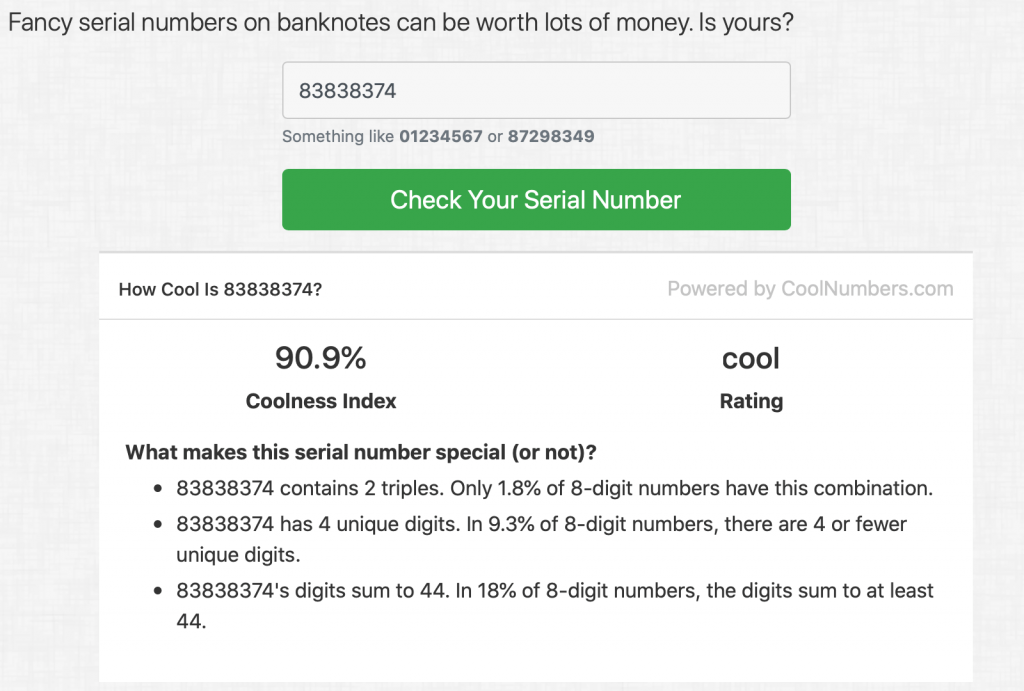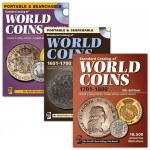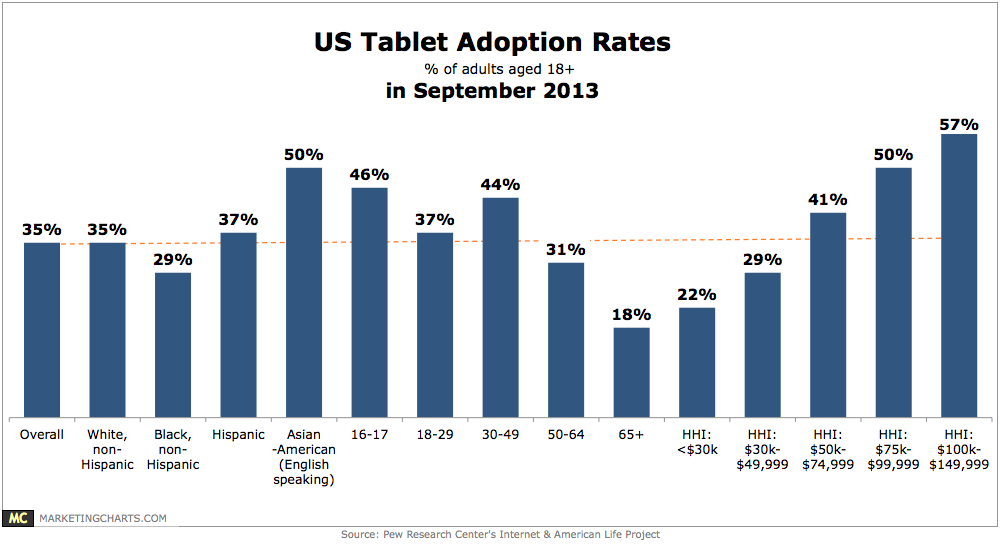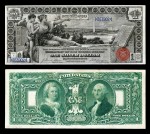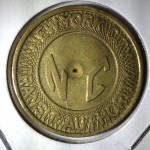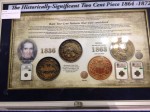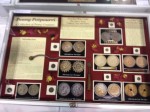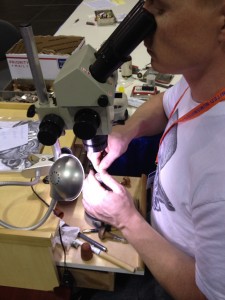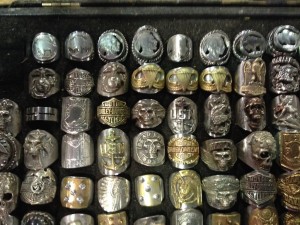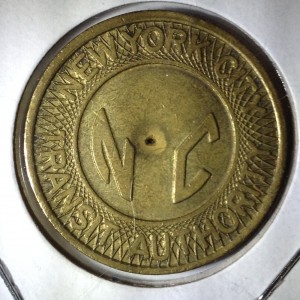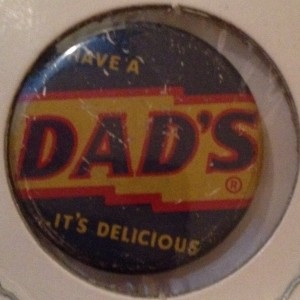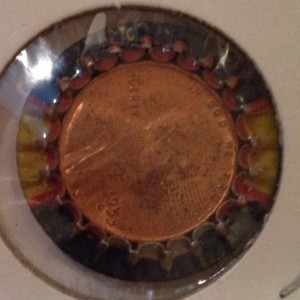Fun With Serial Numbers
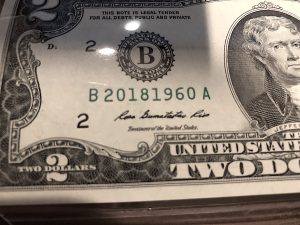
A $2 note from the BEP’s 100 Year Anniversary of the end of World War I. The 2018 part of the serial number was when it was issued and the 1960 was when I was born.
Fancy serial numbers on currency are when there is something special about the numbers. Although some third-party grading services recognize several different varieties, the generally recognized as collectible fancy serial numbers are:
- Binary Numbers: A serial number that contains only 0 and 1
- Ladders: Serial numbers that increase or decrease in order
- Low Numbers: Serial numbers from 1 through 9 are considered the most collectible
- Liar’s Poker: A game that uses the serial numbers in the currency as a poker hand. Each player uses their currency notes and bets who has the better hand. The better the hand, the more the serial number is worth
- Radars: Serial numbers that read the same backward and forwards like 12344321
- Repeaters: Serial numbers that repeat like 12121212 or 12341234
- Rotators: Serial numbers that can be read if you turn the note upside down. The only numbers in rotators are 0, 1, 6, 8, and 9
- Solid Numbers: Serial numbers that use all of the same numbers like 11111111
- Combinations: Any combination of the types, such as 101101 being a binary repeater.
There are other ways to collect serial numbers. One way would be to try to find your birthdate on the currency. For example, if you were born on July 4, 1976, you can look for the serial number 19760704 or 07041976. Some years may be challenging to find since the Bureau of Engraving and Printing has created premium collectibles using the year as the first four numbers of a serial number.
If you do not have a number that can be identified as one of these fancy numbers, does it have a “cool factor?” Grab your currency and go to the Fancy Serial Number Checker. Enter the 8-digit serial number and see what it says.
I found a $1 Federal Reserve Note with a serial number reading 82838374. The site told me that it was “so-so.” It was the best ration I found from the money in my pocket!
- Fancy Serial Number check on a $1 note in my pocket
- What if I changed one of the numbers and tried it again?
You can also play with the number. I was curious about what it would say if the first “2” in the serial number were a “3?” As I suspected, the serial number 83838374 is cool!
Depending on how much cash you have in your pocket, it will give you and your children something different to do!
What e-publishing means for the hobby
Since learning to program computers in 1976, I have been a proponent of technology and its positive effects on the progresses we have made in many areas of our lives. This technology has progressed things we can see like the automated teller machine, quicker checkouts at the grocery stores, smartphones, tablets, and even all the gizmos in your car. If I look at the iPhone in my pocket and compared it to the Poly 88 that I first programmed or the IBM 360 that I submitted punch cards to, it would be like trying to compare a Roman Denarius to an American Silver Eagle.
A lot has happened in the world of technology. In the more than 35 years I have been doing this professionally, I have kept up, adapted, and even embraced new technologies looking for ways to enhance whatever I am doing. Not only have I worked to make technology accessible but in the last 25 years I have been working to keep it safe.I love what technology has done to enhance many aspects of our lives. And you do not have to be a user of technology to have it affect the way you live. Computers help with inventory control to ensure store shelves are stocked; manage traffic control both in the air and on the ground; and generally make the behind-the-scenes management of a lot of things easier including maintenance on this blog.
Since my response to Dennis Tucker, Publisher of Whitman Publishing LLC, I have received a mix of private email notes about one phrase: calling physical books ‘Dead Tree Editions.” In the first two hours after the post appeared, I received more than two-dozen email notes running slightly in favor of physical books. As of Wednesday afternoon, the score was 17-15 in favor of real paper.
I do not know the demographics of those who did not volunteer the information, but based on the comments like, “I have been collecting for umpteen years…” or “I was a teenager when clad coins were just beginning…” it does not take much to get a general idea of demographics.
Of the 17 who responded that they prefer paper books over e-book, I am guessing that 12 are like me, members of the AARP demographic (50 and over).
However, contrary to what some have written, I am not a techno-snob!
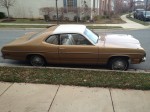
Scott’s 1974 Plymouth Gold Duster. No computers in this baby!!
For more images of this car, click here.
My complaint is not with the preference but the availability of e-books that will allow me and everyone else to choose. I understand the need for choice because neither Whitman nor I will convince everyone to only read e-books.
However, if you look at the demographics of the ANA and its future, the next generation that are its future members, the so-called Generation X people, is the first generation of significant technology adapters and e-book readers. Gen X’ers are the first big wave of technology adapters who know of a connected world and have a vague memory of a world before Al Gore invented the Internet.
Right behind Generation X are the Millennials who grew up with the explosion of the Internet and probably have never read a newspaper cover-to-cover. While hobby publishers may have some time adjusting with Generation X, they will lose completely to the Millennials if they do not adapt.
Whitman is not the only publisher that needs to better examine its use of technology. Krause Publications is not much better. Where Whitman lacks in vision, Krasue lacks in execution. Rather than embrace electronic publishing that is friendly to e-readers, Krause and F+W Media, its parent, is holding onto the old-style by offering its products using Portable Document Format (PDF) rather than using formats that are friendlier to e-readers.
I have purchased the Krause Standard Catalogues and the various antique guides from F+W on CD or DVD because that is what is available. I use them as part of my hobby and my new professional life in the collectibles business, but I wish I had real e-reader formats so that I can use the tools to bookmark and make annotations.Even the venerable Numismatic News has stuck its publishing toe in the e-publishing waters by making one edition electronic. However, instead of embracing the newsstand formats that would be friendly to an iPad or Kindle e-reader, they are mailing PDF layouts of this publication. I hope you have plenty of space in your Inbox.
In the meantime, the American Numismatic Association is producing an e-reader friendly version of The Numismatist that is far easier to read than the PDF edition of Numismatic News emailed monthly. Since The Numismatist reader app works well, I stopped receiving the paper edition of The Numismatist opting for a Basic membership and to read the journal electronically. I do not miss the “Dead Tree Edition.”
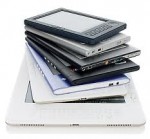 It is not a demographic issue as it is a commitment to the hobby’s future. I am sure the people at Hemming’s Motor News have a similar problem with demographics as those faced by Whitman and F+W. If you read their publications, you will notice that their demographic skews to an older population. Yet, they have quietly embraced the technologies that some of their readers want while still publishing physical magazines. I recently subscribed to the digital version of Hemming’s Classic Car on my iPad and love it!
It is not a demographic issue as it is a commitment to the hobby’s future. I am sure the people at Hemming’s Motor News have a similar problem with demographics as those faced by Whitman and F+W. If you read their publications, you will notice that their demographic skews to an older population. Yet, they have quietly embraced the technologies that some of their readers want while still publishing physical magazines. I recently subscribed to the digital version of Hemming’s Classic Car on my iPad and love it!
How could Hemming’s do this for the auto enthusiasts market but Whitman and F+W cannot do the same for numismatics?
Whitman and F+W have shown that they cannot be relied upon to be the leaders in producing the numismatic information in a way the future of the hobby will embrace. Since other markets have proven that it is possible to embrace technology to enhance the physical world, I can only emphasis my commitment to help the ANA build a better technology infrastructure because if we leave it to the market, they will fail the hobby.
The ANA gets it but does Whitman?
In letter to the editor that will appear in the February 10, 2014 edition of Coin World (now available online), Dennis Tucker writes that the target of the American Numismatic Association website rebuild and acknowledging “’Young Numismatists are the future of the hobby’ are slogans to murmur approvingly, without logical reasoning.” He goes on to give his view of the market to target without recognizing facts of market forces.
For the record, Dennis Tucker is the publisher of Whitman Publishing, LLC whose books are widely read in the hobby. Whitman Expo, a division of Whitman Publishing, runs probably the three largest commercial numismatics shows in the country out of Baltimore.
Tucker, whose business is selling physical books, or what I would call “dead tree editions,” opines that it would be wiser and more productive to target those in the 50 and 60 year old demographic than 10 and 20 year olds. It is obvious that Tucker is looking at the issue from the spectrum of the business he is responsible for rather than the real future.
One problem with Tucker’s argument is similar to those in many other hobbies that rely on the collecting of physical objects: if the hobby cannot be translated to the younger demographic then the future of the hobby will be lost. As the final wave of the baby boomer generation celebrates their 50th birthday this year, empty chairs are becoming more prominent at meetings with fewer standing there to fill those chairs. There seems to be a smaller pool of people ready to join even though the population in the demographic that Tucker wants to target has grown.
Another problem with his argument is that it does not address how to reach this or any other demographic. Based on his company’s business model and his letter, Tucker is implying that even his target demographic is not using technology and cannot be reached using technology. Unfortunately, that flies in the face of researched facts.
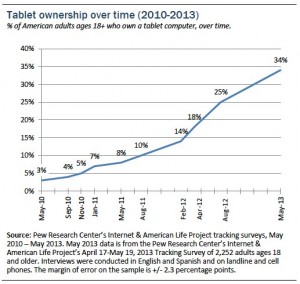
Pew Internet and Lifestyle Study: For the first time, a third of American adults own tablet computers
Using tablets as a barometer, we can look at the “Tablet Ownership 2013” report from the Pew Internet and American Life Project. In their study, Pew reports that through May 2013, tablet ownership has grown from May 2010, one month after the iPad’s introduction, the number of tablet users have increased from 3-percent to 34-percent. That is more than an 1100-percent increase in three years!
Further, Pew’s research found that the demographic with the most significant ownership are the age group of 45-54 with 38-percent ownership and 35-44 with 49-percent. The first is part of the market that Tucker wants to target while the latter is the market that should be next.
Pew’s research also looked at tablet ownership by income and found that 56-percent of adults that own tablets earn $75,000 or more per year. If Tucker’s goal is to target those with disposable income, just look at one of the fastest growing area of technology to understand where the markets are going.
Another study recently release by Pew notes that e-book readership has grown as the sales of e-readers have risen. While the study does not say people have not completely replaced their dead tree versions with electronic editions, there is anecdotal evidence that if more titles were available electronically, those with e-readers would take advantage of that.
In a broader look at the emerging online world, Pew Research provides trend data that shows that more people are using the technology in their daily lives. Not only are more than 60-percent of the 50-64 year old demographic using the Internet and associated technologies a large numbers, but e-reader ownership is increasing. It is also increasing in the younger demographics, including those in the 30-49 year old range who would be Tucker’s next generation of customers.
The ANA, like any business, has to adapt to new markets or they lose their relevancy. It is not enough to say to target one group over the other but you have to target the markets where they are moving. Even if the business is concentrated in one market, it has to adapt and diversify within its market or it becomes irrelevant. As a stark example, you can look at the downfall of Blackberry. Once the king of the smartphone, Blackberry, once called the Crackberry because its users were addicted to it like a crack addict was addicted to crack-cocaine, went from the most popular phone to the least popular phone because they ignored the trend set first by Apple then by Google’s Android.
History shows how significant technologies disrupt markets and those that do not adapt go the way of the buggy whip, blacksmith, telegraph, Kodachrome film, and the Motorola DynaTAC phone. If the ANA cannot reinvent itself by adapting technology to what its potential members are doing, the ANA will go the way of Blockbuster, Polaroid, and Borders Books.Whitman and Tucker could help the ANA by looking at this future and target their books to this growing demographic. While the quality of Whitman’s books have improved, the companies selling tablets and e-readers are reporting increased sales of their products and an increased sales of content for those products.
Amazon is betting a lot on the tablet and e-reader market. They sell the Kindle nearly at their cost in order to lure customers into their dedicated markets. Amazon hopes to sell you a Kindle so that you buy their e-content which they make money by transferring bits. Not only has Amazon built in the infrastructure to transfer bits of information, but they are selling it as a service to others in order to reach the same markets. Amazon is betting that once you are in their market, they can sell you these bits, which are cheaper to store, package, and ship than dead tree edition books.
While the e-book market is growing, Whitman and other hobby publications are dipping their proverbial toes in this market. Although Whitman does offer a number of its books in e-reader format, they do not market that fact nor do they do any outreach in order to build that market. It is as if they publish this content so that when the topic comes up they could say that they do have e-books. They are checking the box, so to speak.
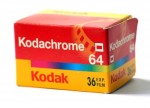
Kodachrome; You give us those nice bright colors; You give us the greens of summers; Makes you think all the world's a sunny day, oh yeah!
Growing the ANA is like growing a business; you have to look at what your target market’s demographics are and figure out how to reach them. For hobbies like numismatics, the new target is online where the current generation is moving and where the next few generations will be. Not adapting to those new markets can make both the ANA and Whitman as relevant as the Betamax and go the way of Woolworth’s or Pets.com.
I am glad the ANA is doing something to expand its market.
Data chart of the Pew Research courtesy of marketcharts.com
Image of Borders closing is courtesy of PennLive.com.
Kodachrome box image courtesy of Wikipedia.
Kodachrome lyrics (image caption) by Paul Simon
How can we expand the hobby?
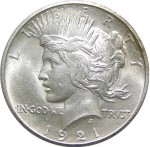 If you have not read “Hobby Must Fill the ‘Empty Chair’” that Michael S. Turini wrote a few weeks ago, then click here to read it first. Go ahead, I’ll wait.
If you have not read “Hobby Must Fill the ‘Empty Chair’” that Michael S. Turini wrote a few weeks ago, then click here to read it first. Go ahead, I’ll wait.
How do we fill the empty chair?
After years of growth spurned by the 50 State Quarters program, the hobby seems to have plateaued at levels lower than expected. Explanations for the slowing in the hobby’s growth range from the downturn in the economy through the downturn in confidence of the products being produced by the U.S. Mint.
I think Michael Turini stumbled on the problem: those of us most interested are getting old.
Not only are we getting old, but we are not doing what it takes to make numismatics inviting to younger members.
We seem to do pretty well in attracting young numismatists (YN), those under 18 years old. In fact, there are programs that actively recruit YNs for the hobby. But we are not doing enough. Not only are there no programs to keep YNs interested after they stop being YNs, there is a real lack of diversity in the hobby.
During my recent trip to Orlando for the 2014 FUN Show, I noticed that there were an increased number of women than I have seen at other shows. I also noticed that other minorities were attracted to the show. Seeing this was great, but how can it be spread to more areas of the hobby?
Numismatics can be a fascinating look at our history. The money that was used reflects the economy of the time which can tell a great story. What can the Morgan dollar teach us about the history of silver, the economy, and the politics of the time that could interest someone? Would learning about the ‘Crime of ’73’ make people think differently about the impact of politics on our economy?
What about the Educational notes series? These one, two, and five dollar notes depict neoclassical allegorical motifs as a representation of the theme written on the front of the note. The back pictured two American figures. Aside from the phenomenal artwork, why were they produced? What was the Bureau of Engraving and Printing hoping to do with these notes?Our thoughts may also be too old.
There are great stories in other areas of numismatics beyond coins and currency. So-called dollars, tokens and medals the size of a dollar coin, were struck to commemorate something, some event, dedication, or anything of significance. So-called dollars tell stories that coin cannot and yet does not get the same attention in the numismatic press as coins.
If you are looking for new numismatic areas to explore or to use as a source to educate someone about history using numismatics, what about items like trade tokens or tax tokens? Trade and tax tokens were local currencies used to build business. In many ways, trade tokens could be considered coupons before someone issued paper coupons!
Transportation tokens traces the history of mass transit which can make learning local history fun. For instance, a New Yorker can easily find subway tokens that can tell the history of both the subway and economics since the tokens were first issued in the 1950s. Adding a Metro card to your collection also explains why the token is no longer used.In Canada, there are collectors who collect the interesting coupons from a particular tire company.
I know a European-based collector who collects communion medals from a particular region because it traces the history of Catholicism in the area where his family has lived for centuries.
You can even collect the coins of the country where your ancestors or other members of your family are from. I became interested in Canadian coins since my wife’s family is from Canada. Now I am looking at the large cents produced during Queen Victoria’s reign which are affectionately called ‘Vickie Cents.’
Numismatics does not have to be about plugging coins into the holes of a folder or album. It does not have to be about buying coins encased in plastic holders with high numbers or extra symbols. Use numismatics to learn about your past. You can learn more about yourself by understanding your past and what better way to understand your ancestral past than to collect something from that era.
Go collect something new and make sure you tell people about your finds. Tell someone the interesting stories of the past using numismatics as the prop. Make sure you tell them they can have fun with this, as well. Then invite them to your next club meeting and make sure someone is there to talk about their finds and history.
It is only when we can move beyond the cold metal and paper to make the stories interesting can we think about filling all of the empty chairs in the room.
ANA to share the stage with PNG in August
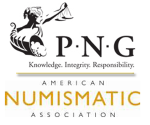 According to a press release issued on January 15, 2014, the Professional Numismatists Guild and the American Numismatic Association will jointly host “the first” PNG-ANA Numismatic Trade Show the weekend prior to the 2014 World’s Fair of Money in Rosemont that will be open to the public.
According to a press release issued on January 15, 2014, the Professional Numismatists Guild and the American Numismatic Association will jointly host “the first” PNG-ANA Numismatic Trade Show the weekend prior to the 2014 World’s Fair of Money in Rosemont that will be open to the public.
The PNG-ANA Numismatic Trade Show will be Saturday through Monday, August 2-4, 2014. The World’s Fair of Money will be held Tuesday, August 5 through Friday, August 9, 2014.
Doing this eliminates PNG Day(s) prior to the World’s Fair of Money and will extend the entire show week to eight days.
It was my understanding the PNG Day was for PNG members to buy and trade amongst themselves to prepare inventory for future sales. Inventories were bolstered by wholesale dealers or dealers who would rather sell to other dealers rather than staff a table at the World’s Fair of Money. While it was closed to the public, it was possible to either buy your way into the PNG show or get an invitation from a PNG member dealer.
What may have been the driver of this decision is that it was getting easier to obtain an invitation from a PNG dealer. Citizens of some of the popular coin forums would be able to download an invitation posted by member dealers to use for PNG day. A friend who attended PNG Day in 2013 said that non-members clearly outnumbered members by a large margin.
Where I question the decision is that it makes the show eight days long—emphasis on long. While some dealers will not attend both shows, there are many dealers who will be there all week. Those of us who are buyers know that some dealers can get surly toward the end of a show like the World’s Fair of Money. Can you imagine how prickly these dealers will be by August 8?
With the show ending on a Friday, a day that will attract local attendees, will the long show, cranky dealers, and the inevitable empty tables turn the World’s Fair of Money into a bad showing for the ANA?
As part of the PNG-ANA show, there will be a daily give away of a Double Eagle gold coin that will be donated by a PNG member dealer. There will also be an auction by Stacks-Bowers Galleries.
There will be no similar give away for the World’s Fair of Money. Both Stacks-Bowers and Heritage Auctions will combine to be the official auction of the World’s Fair of Money.
Since Numismatic Guarantee Corporation is the official grading service of both organizations, they will be present for the entire week. Good luck keeping staff motivated!
This decision brings back the concept of a pre-show that was discontinued because it was poorly attended and made the week too long. It also has the possibility of up staging the ANA and the World’s Fair of Money.
Since most collectors work people outside of the numismatics industry and Rosemont is not exactly a destination location for families, this will increase the attendance during the weekend of the ANA-PNG show rather than during the week for what should be the premier show, the World’s Fair of Money. Casual collectors who have to arrange for travel and time off from work will be more attracted to the co-branded show on the weekend rather than the ANA show.
The ANA should not give up its premier status to share the stage with PNG.
While the ANA should work with PNG and other organizations, the ANA should not play second fiddle to any other organization regardless of the organization. If the ANA wants to be the premier numismatic organization, the one that anyone wanting to learn about and be about numismatics, this type of partnership that has been clearly driven by PNG is not the right way to be premier.
This is a bad decision for and by the ANA.
Weekend of FUN
Going to a coin show in another area of the country is an education on seeing how others do the shows and meeting dealers who do not travel to your area. For me, attending the FUN Convention in Orlando was this type of experience. Yes, there were the usual big name, high volume, and high-end dealers present as they are at any show, but there are other dealers whom I have never met before.
Saturday was spent in three parts. When I arrived at the convention center, I went directly to the exhibits area. As a wannabe exhibitor with two (what I think are) good ideas, I wanted to see how others present their ideas. For the most part, I was a little disappointed in the exhibits. Many were mundane and typical. There were only a few exhibits that really stood out.
One of my favorites was a display on the two-cents coins that I found out was put together by Tom Uram, President of the Pennsylvania Association of Numismatists. What made the exhibit interesting is that rather than a flat display, he dressed it up using story boards on a backing that was raised from the bottom of the case, and colorful. It looks like Tom understood that the short-attention-span nature of somebody looking at numismatic material would be more attracted to and attractive presentation. The other exhibit that was clearly about the others was Charmy Harker’s “Penny Potpourri.” Charmy reprised the exhibit from her near sweep at the 2013 World’s Fair of Money to sweep the awards at FUN including Best in Show and People’s Choice. If you have not seen this exhibit, it chronicles the various items made from the little copper one-cent coin. From small tools, decorative items, to dollhouse items, it is amazing what Charmy found. After all, she is known as “The Penny Lady” so it would be natural for her to put this type of exhibit together.The second part of my day was schmoozing. There is nothing like meeting numismatists of all type on a bourse floor and just talk with them. I spoke with people I know, dealers I did not know until I sat at their table, and with visitors looking at various items wanting more information. I had the most fun at the American Numismatic Association traveling exhibit explaining the history behind the various items of currency that were on display.
Speaking of the ANA traveling exhibit, I was a little disappointed in the presentation of what was exhibited. Aside from not having the currency labeled with information, the case with the errors had just coins placed in the case without description or context. Many of the bland collector exhibits were done better than what the ANA presented.
FUN organizers understand that the idea of having a how is to have fun (pun intended). One exhibit area that I have only seen at FUN is the artists’ area. The artists’ area was in the back of the hall off the center aisle where tables were set in a square that hand artists making jewelry and art from coins. There were a number of artists making modern Hobo Nickels, a bead artist who used coins as part of the beading work, and someone who made large rings with carved coins.
Another fun area was the panning for gold. On the other side of the hall was a large booth set up with troughs that had mud and tiny gold nuggets. It was fun to walk up and watch the kids swirl the pan and find a tiny gold nugget. I do not know how much gold was in that water, but it was a lot of fun giving it a try. No, I did not find a gold nugget!
Of the large shows I have attended, FUN has had the most diverse attendance. There seemed to be more families, women, and minorities than even at the World’s Fair of Money. Another pleasant surprise was the number of women taking the lead with the young numismatists around the bourse floor and many of those YNs being girls. There were also quite a few Hispanic collectors with their YNs buzzing around the floor. Since I do not speak Spanish I could tell they were enjoying themselves just be observing their body language.
Diversity is good in both the hobby and life. No single group has the answers and attracting people with diverse backgrounds and perspectives is good for everyone. I do not know if the organizers of FUN advertise the show in minority communities or in areas that would attract diverse interests, but they should share what they do with the rest of the numismatic community since it is working.
As for my purchases, I was looking for a few silver bullion coins. Of the ones on my personal want list I was able to pick up the 2013 25th Anniversary Canadian Silver Maple Leaf and the 2014 Chinese Panda. I did not find the 2013 all-silver Britannia and I forgot about the 2013 and 2014 Australian Silver Koala. Since I already own the 2013 American Silver Eagle Proof, I should be almost caught up with my silver collection.
In my attempt to find something that I can say “oh… neat,” I did find three items that category. First, to add to my New York City collection is a Type 2 or “Large Y” subway token without the large “Y” punched. This token would have been used from 1970, when the fare was 30-cents, through 1980 for a 50-cents fare. I have seen many mis-punched tokens, but this is the first I have seen without the “Y.”
My next “oh… neat” item is a Dad’s root beer bottle cap but with a 1953-D Lincoln cent wedged inside the cap. I do not know if this was done by Dad’s or someone else, but the folding of the cap around the coin looks too perfect to have been done manually. Even if it was done by someone as a good luck piece, it was very interesting.
Finally, I found a 1940’s era oil rationing coupon book. Obviously issued during the war, the coupon book limited the holder to up to $25 of home heating oil from the Service Oil Company of Hibbing, Minnesota. Hibbing is in what can be described as northeast Minnesota where it is not exactly warm. As I type this, the Weather Channel is reporting that the temperature in Hibbing a 1F! What makes this coupon book unusual is that it is unused with all the coupons attached from frigid norther Minnesota. It has survived over 60 years in nearly pristine condition. Now that is “oh… neat!”
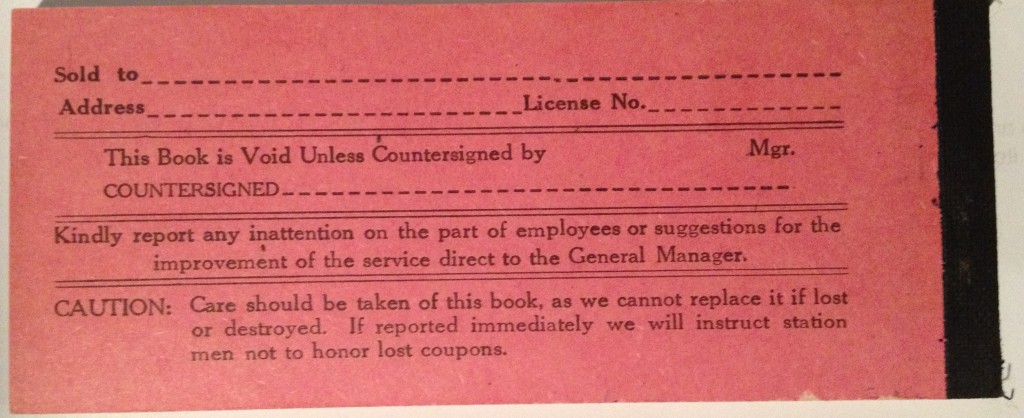
Back cover of an unused home heating oil coupon book. It was printed for but never issued by Service Oil Company of Hibbing, MN
If you have not been to FUN you should try to go. At least take the family. They can go to a theme park while you hit the bourse floor!
Photo Album
All images can be found here on Photobucket

